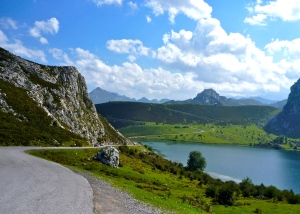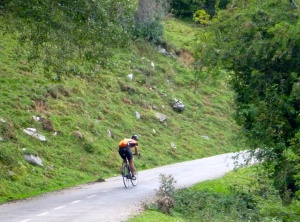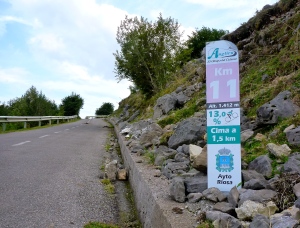The day after L’Angliru we climbed the road to the lakes of Covadonga. I was more keen than ever to climb steep roads. I was hoping, Lago the Covadonga would be as steep as L’Angliru.
The pain was forgotten. The images of the Vuelta a Espana battle between Rodriguez and Contador from a couple of weeks earlier were still vivid in my mind. I knew it would be a beautiful, scenic ride. I had seen it on TV.
And I wasn’t disappointed on that part.
We parked our motorhome just outside of Cangas de Onis at the very large and free motorhome car park that even had free servicing facilities. From there it was a short ride to the start of the climb, not more than five to eight kilometres, which I doubled by returning to the motorhome to pack my rain jacket, just in case the dark towering clouds above the picos would drop some rain on us. They didn’t.
Once past the village of Covadonga with the impressive church, and once past the forest, the climb opened up to a karst landscape. The higher we got, the more glaring the white of the limestone rocks became. It contrasted so beautifully with the green of the grass and the blue of the sky and I found it hard to take my eyes off the surrounding. The road was climbing gently so I had plenty of energy to admire the views.
And I was feeling so strong, so fit and still so proud of my El Angliru achievement the previous day that I was really looking forward to the steeper part that surely was waiting for me further up. In the TV footage of the Vuelta it had looked vicious.
And surely, the road did steepen to maybe 11, maybe 15%. Somehow it left me wanting for more of a challenge. Amazing how, at the beginning of our trip, I would have perceived this climb as really tough.
And while I was still wondering when the challenge would start, we turned around a corner, a rock face and a crest and, there it was, the first of the two glacial lakes, Lago de Enol. The view was breathtaking, the clear air, the sparkling surface of the water, the green grass around the lake dotted with caramel coloured cows holding siesta.
We raced the motorbikes down the short descent before climbing the last couple of kilometers up the opposite side of the lake, over the ridge and across to the second lake, Lago de Ercina. We didn’t stay long because the car park was packed with day trippers. There were people everywhere, kids screaming, hiking out to the edge of the lake or into the mountains, some just enjoying the sunshine and the views.
I was really sad that we had to press on. Once again, and you are probably sick of me saying it, I would have loved to linger on. Asturias and the Picos de Europa, of all the areas of Spain that we have visited, was definitely the area I liked best, and if I will ever have the chance to return to Spain with my bike, I will make sure I schedule a whole week or two in Asturias for the cycling, and also for the food. It’s the best of Spain in my view.
Now, I’m almost at the end of my travel tales from 2012. There is only the Basque Country left to tell you about… it’s the heart of Spanish cycling culture so stay tuned for the final chapter.








































